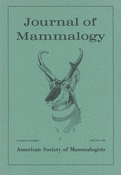-
Views
-
Cite
Cite
G. J. Kenagy, Stephen C. Trombulak, Size and Function of Mammalian Testes in Relation to Body Size, Journal of Mammalogy, Volume 67, Issue 1, 25 February 1986, Pages 1–22, https://doi.org/10.2307/1380997
Close - Share Icon Share
Abstract
We have assessed the allometric relationship between mass of testes and body mass using data from 133 mammalian species. The logarithmically transformed data were fitted by a regression (r2 = 0.86) that is described by the power function: Y = 0.035X0.72, where Y is mass of both testes in grams and X is body mass in grams. The slopes and intercepts of the allometric relationship for rodents alone (62 species) and primates alone (28 species) do not differ significantly from the relationship for the 133 species all taken together. Smaller mammals must allocate a greater proportion of body mass and of energy expenditure to testicular tissue than larger mammals; according to our allometric equation the testes of a 10 g mammal should comprise 1.8 percent of body mass, whereas testes of a 10,000 kg mammal amount to only 0.04 percent. Among the smallest mammals, the range of relative testes size is great; the testes of some rodents are as large as 8 percent of body mass, whereas others are as small as 0.15 percent. The energy cost for growth, maintenance, and production by mammalian testes is proportional to mass of testes and is, therefore, in most cases negligible. Among mammals in general we found no correlation between size of the testes and their location (abdominal or scrotal) in the body, or between size of testes and body form and mode of locomotion (terrestrial, aquatic, aerial). A functional relationship exists in many mammals between relative size of testes and mating system. Testes are relatively small in single-male breeding systems (monogamy or cases of extreme polygyny in which a single male does all the breeding). Testes are relatively large in multi-male breeding systems (promiscuous or polygynous systems where several different males mate with each female at the same estrus). In these cases, the evolution of large testes can be attributed to high copulatory frequency and sperm production and the competition among sperm of different males for fertilization of the same female. Size of testes has undoubtedly evolved in each species in response to a variety of additional factors beyond the first-order influence of body size. Tests of further hypotheses (for example, degree of seasonality of mating) that may explain the additional variability in size of testes should be performed. This should involve multivariate analyses of large data sets or simpler analyses that use data sets restricted to animals of similar body size, lower-level taxon, mating system, etc.





